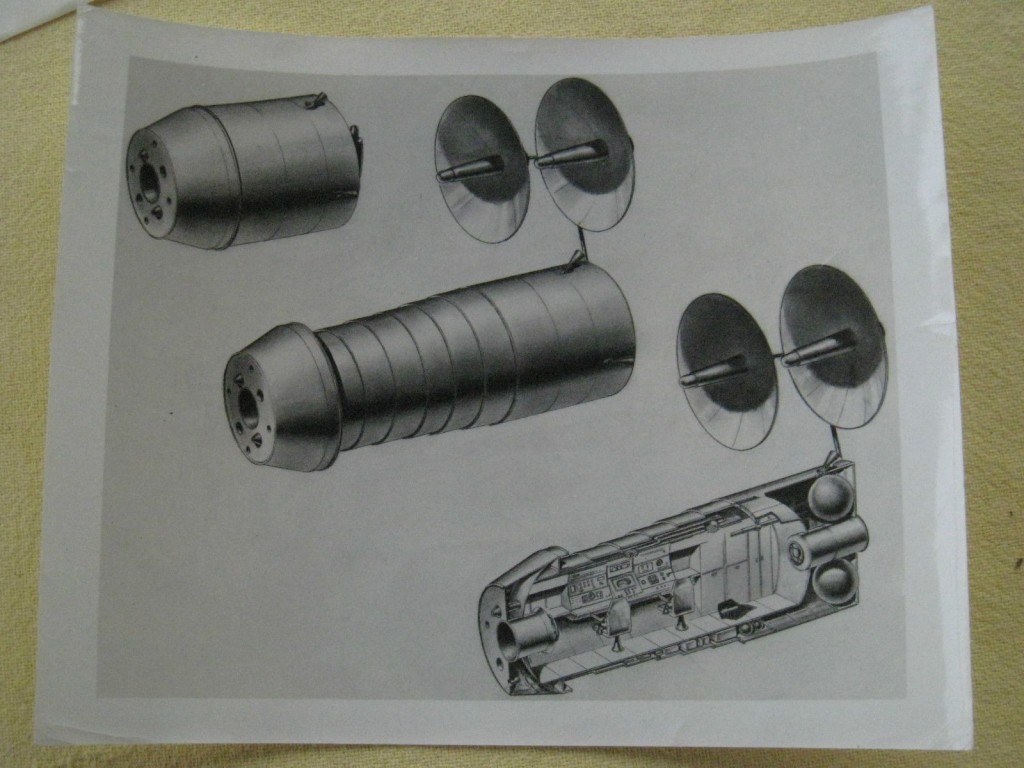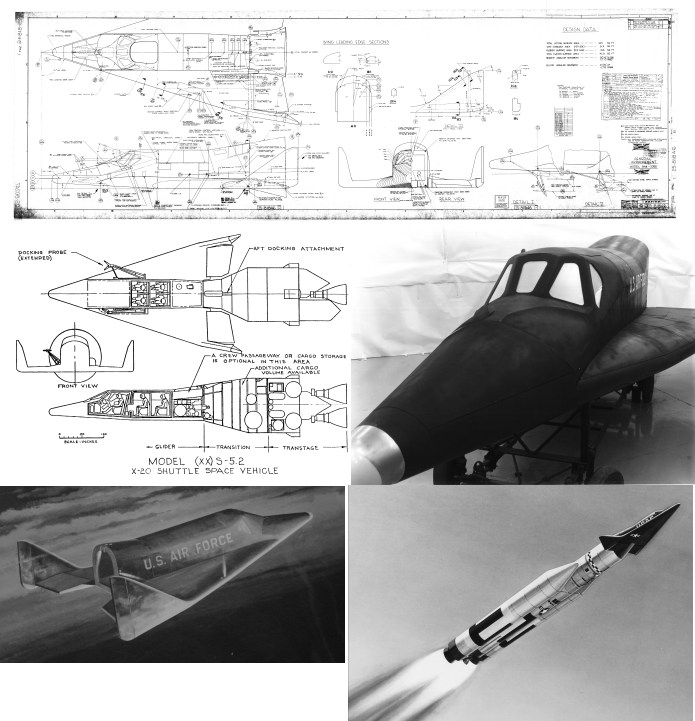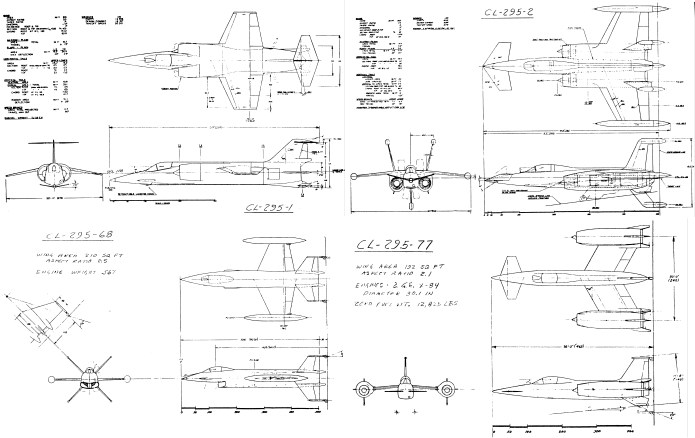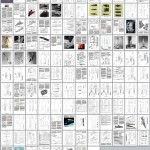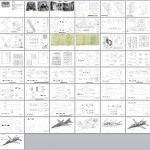Found on eBay, a set of fridge magnets printed with three manned United Launch Alliance launch options: the Boeing CST-100, the Sierra Nevada Dream Chaser and the Orion capsule in the Exploration Flight Test 1 (first unmanned flight) configuration. I’ve not found better versions of these illustrations elsewhere, sadly. This image was processed a bit to straighten and brighten the photo posted on eBay.
In the mid 1960’s, the McDonnell Aircraft Company devoted some internal funds and effort to the F-4(FVS). This would have removed the wing from the F-4 Phantom II and replaced it with an all-new shoulder-mounted swing wing. The target of this enterprise was primarily the US Navy; MAC assured them that the F-4(FVS) would be a superior carrier plane to the standard F-4 due to better low-speed handling characteristics. However, while the design seems to have been pretty sound, by this point the Navy wanted a capability the Phantom couldn’t provide: Phoenix missiles. In the end, the Navy largely ignored the F-4(FVS) and went with the F-14. But even then, McDonnell-Douglas proposed a design for the F-14 contest, the Model 225A, that was in part derived from the F-4(FVS) studies.
A whole lot more about the F-4(FVS) and the Model 225 are in Aerospace Projects Review issue V3N4.
Saw this on eBay a while back. No further data. I assume it’s from the early/mid 1960’s, early MOL era. I don’t imagine that it was a particularly serious study; I’ve never seen it’s like elsewhere, and it seems like it would be quite heavy and prone to leaks. A reasonable guess would put the diameter at 10 feet, standard for the time (same diameter as the Titan II/TIIIc core vehicle).
I tinkered a bit to fix the warping and clean up the image:
A rather uninformative (no narration) NASA-Langley video of supersonic wind tunnel testing of the proposed Space Launch System. Interesting for the shots of the model itself (nice to see actual models, rather than just CGI), as well as a few shots showing the shock waves shed off the body.
[youtube 8NxB0KAsous]
In 1962, NASA-Marshall Space Flight Center kicked off the EMPIRE (Early Manned Planetary Interplanetary Roundtrip Expeditions) studies. This was a preliminary examination of manned missions to other planets, mostly looking at Mars, with Venus flyby and orbital missions as well.
Contracts went to General Dynamics, Lockheed and the Aeroneutronic Division of Ford. Yes, Ford, the car company: at the time, rather than the American aerospace industry being so tightly contracted that there were only a handful of players, the industry was so lively and vast that *car* companies were doing good business in aerospace (Chrysler built the Redstone rocket, the first stage of the Saturn I and even proposed an SSTO for the Shuttle program).
General Dynamics/Convair produced the best known of the resulting studies. With much of the work overseen by Krafft Ehricke, there was a distinct sense of enthusiasm to it; much of the results of the EMPIRE study crossed departments and ended up in General Atomics Project Orion work. One portion of the EMPIRE design that Orion adopted was the manned Mars Excusion Module (MEM).
In configuration the lander looked much like an Apollo Command & (shortened) Service Module with three landing legs. instead of a conventional parachute, it used a metal ring that was to serve much the same purpose. The Mercury-like “Abort Tower” was to be used at liftoff; it would drag the ascent vehicle up far enough that ignition of the main engine would not through debris around that could strike and damage the ascent vehicle.
Sadly, this design was produce before the Mariner 4 probe flew by Mars . The data sent back by Mariner 4 showed that the atmosphere of mars was more than an order of magnitude thinner than had been expected, with the result that aerodynamic braking would be far more difficult. Thus, this design simply would not have worked on Mars; it would have slammed into the ground at high speed.
A Northrop title block from an inboard profile of the N-144 Long Range interceptor (Air Drawing 31).
At last: Aerospace Projects Review issue V3N4 is available. This issue has 128 pages. The main article focuses on the Boeing Model 844-2050E, the final, almost-built version of the X-20 Dyna Soar spaceplane. Included are not only detailed diagrams showing the design and construction of the spaceplane, but also drawings and information on proposed operational versions, including passenger ferries, satellite inspectors/interceptors, even nuclear bomber versions.
Also included are a large number of all-new diagrams that finally show the Dyna Soar atop the Titan IIIC accurately and in detail, along with proposed variants, variant launch systems and suggested space stations.
An article by Bill Slayton on the Lockheed CL-295 design series. This was a series of tailsitter VTOL fighters including designs derived from the F-104 as well as wholly new designs.
The third article is on the McDonnell F-4(FVS),a mid-1960’s concept to replace the low-mounted fixed wing of the F-4 Phantom II with an all-new variable geometry “swing wing.” The story goes from the F-4(FVS) in its numerous incarnations through the Model 225, McDonnell-Douglas’ entry into the 1968 US Navy VFX contest which resulted in the F-14.
Also, Aerospace History Nuggets on the US Navy SCAT VTOL and the Republic Aircraft RAC-730 SSTO aerospaceplane.
23 megabyte PDF file
Here’s the complete issue V3N4 layout:
It is available in three formats. Firstly, it can be downloaded directly from me for the low, low price of $10.00. Second, it can be purchased as a professionally printed volume through Magcloud; third, it can be procured in both formats. To get the download, simply pay for it here through paypal.
——–
———
To get the printed version (or print + PDF version), visit my MagCloud page:
http://scottlowther.magcloud.com/
——————
Also available: the V3N4 Addendum. This contains 49 pages formatted for 11X17. Includes larger and improved versions of all the CAD diagrams produced for V3N4, as well as larger versions of some of the illustrations from the X-20 and F-4(FVS) articles (as well as a number of illustrations that did not appear in the X-20 article):
The V3N4 Addendum can be downloaded for only $4.00!
——–
———
Here’s another one of those “I was sure I’d posted it before, but now can’t seem to find it” items…
A 1948 promo video by Northrop showing a mockup of a passenger compartment to be built into a B-49-style flying wing. Very spacious, and with one heck of a view to the front and rear, but of course none to the side. The idea of flying wing airliners keeps popping up, but also keeps never happening. There are several decent reasons for this:
1) It’s more difficult to pressurize the non-cylindrical passenger compartment, meaning that it’ll weigh more (and thus negate some of the weight savings of using a flying wing)
2) Configurations like this won’t fit quite so conveniently at most airports. The jetways will have a hard time mating up.
3) Most of the passengers won’t have any sort of view at all, it’d be like flying in a cargo container.
4) The further a passenger is left or right from the centerline, the more disconcerting and uncomfortable rolling maneuvers will be for them.
5) It’s different. The Dash-80 (the prototype for what became the KC-135 and 707) set the basic configuration for the modern jetliner in 1954… 60 years ago. The most modern jetliners don’t really look any different. And like it or not, “convention” matters.
Northrop drawings of this jetliner are HERE.
[youtube JMTwQ9b5hvk]
I’ve slapped together a Patreon “campaign,” but I have not yet launched it. However, I’ve stitched together the screenshots of the thing, shown below, listing the “milestones” and the “rewards” I’m considering. In short, I have a fairly good sized library of stuff I’m fairly certain would appeal to a fair number of folks, and this would be a way to get it all scanned and cleaned and posted and whatnot. The way this works, the more an individual contributes, the higher the quality of product they’ll get, and the more the total contributions, the faster the rate stuff will be put out there. The specifics might change, but I think this is a proper sort of setup.
If you have a suggestion or any sort of comment at all, feel free. Advertising, marketing, all that stuff… not my area. So if you see something stupid, or something that could be better, let me know.



